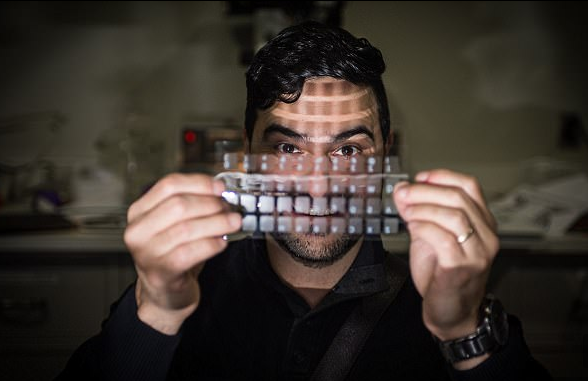By Nicole DiGiose
Grabbing a newspaper on the go and having it talk to you, reading its contents aloud, may sound like a concept straight out of a J.K. Rowling fantasy novel, but according to researchers from Michigan State University, it could soon become a reality.
Known as the ferroelectret nanogenerator (FENG), the team of researchers created the device with a silicone wafer, which was fabricated with several layers of environmentally friendly substances including silver, polyimide, and polypropylene ferroelectret. Then ions were added so that each layer in the device contained charged particles. The purpose of this is to create electrical energy when the device is compressed by human motion, or mechanical energy.

The FENG can generate energy from human motion and can also act as a loudspeaker and microphone. Image source: Michigan State University.
The most impressive part? This paper-thin, flexible fabric can not only generate energy from human motion, but it can also act as a loudspeaker (by converting electrical energy to mechanical energy) and microphone (by capturing vibrations from sound or mechanical energy and converting it to electrical energy). The audio breakthrough could eventually lead to consumer products such as a foldable loudspeaker, a voice-activated security patch for computers, and even, yes, a talking newspaper.
To demonstrate the microphone effect, the team developed a FENG security patch that uses voice recognition to access a computer. The patch proved successful in protecting an individual’s computer from outside users.
As for showing off the loudspeaker effect, the researchers had the FENG fabric embedded into an MSU Spartan flag. Music was transferred from an iPad through an amplifier into the flag, which reproduced the sound flawlessly, without missing a beat. Perhaps in the future, instead of using bulky traditional speakers, this flexible, small device can be used instead.
Of course, this brings about the exciting ideas mentioned above. Imagine a newspaper where the pages function as microphones and loudspeakers. Something like this could mean having a voice-activated newspaper that talks back to you.
Nanotechnology researchers originally reported this technology in Nature Communications. The research was funded by the National Science Foundation.
What are your thoughts? Leave a comment below.
Advertisement
Learn more about Electronic Products Magazine





